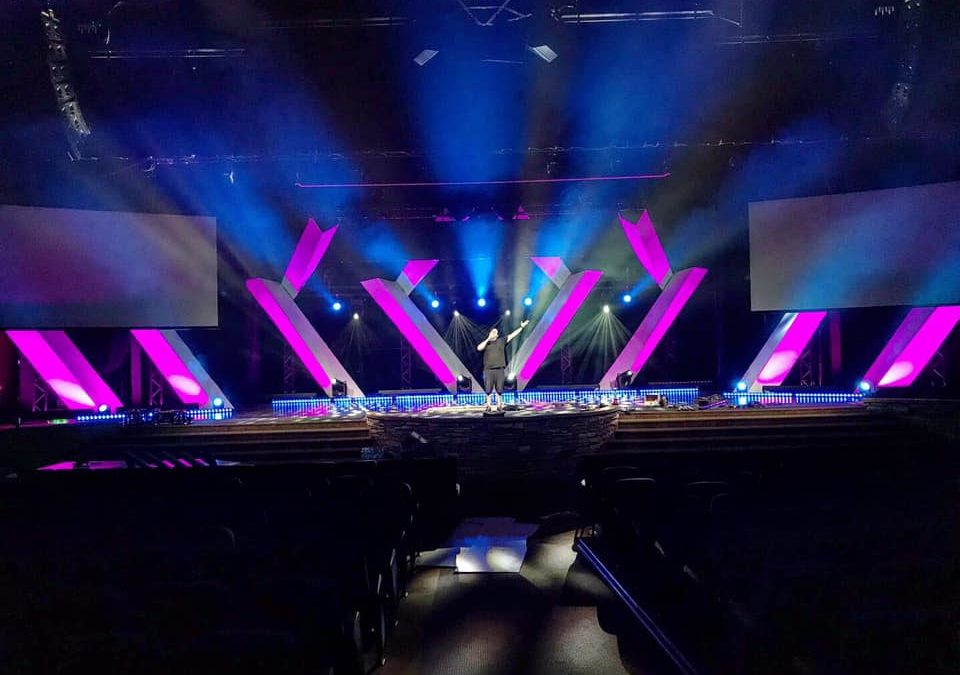Welcome to the Mod Scenes podcast. This is your host, Stephen and I am thrilled to be chatting with you today about stage designs and creating great stage backdrops for your next event, uh, your church, uh, or really anything you need to stay for back drop for. So, uh, let’s jump into the podcast today. Um, today my goal is to make a podcast of puns. So, um, I’m going to talk to you about a stage design that you will probably be tired of hearing about that stage design is a backdrop made of vehicle, uh, tires. So you’ll be tired of it. Did it? That one? Wasn’t very good. Okay. I’m sorry. Uh, so specifically the, uh, the stages I’m thinking about is, uh, I believe it was live aid. Uh, they did a stage design where they took hundreds, like, like over 200, uh, tires. So automobile tires, they might’ve used semi tire, but nonetheless hundreds of tires and they painted them different colors.
Most of them were white, but they also had some black and red ones in there. Um, and then in between inside each of those tires, they put, um, they put a light, I believe it was, um, quite a while since I’ve seen it, but it was, uh, it was a pretty cool stage design. So, um, so I was just kinda thinking through that and thinking through what some other ways we can do, uh, stages design, uh, there’ll be similar. Cause I was like, well, you know, uh, that could be a stage design. Like somebody could use that as a stage design it, get a bunch of tires and paint them. Um, but then you come to this issue with making a stage design of tires, uh, that if you make a stage backdrops, excuse me, stage backdrops out of tires, then you have to get rid of the tires at the end.
Uh, which is the hard part because, uh, I believe it’s shoe to $5 depending on where you are in the country to take them in for recycling or whatnot. Um, so if you’re talking about over a hundred of them, you know, it’s like 500 bucks just to take, just to go throw these away. Uh, so, uh, maybe not that, um, anyhow, let’s, let’s talk about, uh, some other ideas for, uh, interesting materials for stage design. So obviously the most interesting material in my opinion is firing plastics because they’re super easy to use. Um, they’re safe, you’re never going to burn down the building with them. Uh, you can change them and cut them and create them into whatever you want them to be. Um, but let’s think about things that are outside of that, just for, uh, just for the sake of, uh, thinking about ideas.
Uh, obviously woods are pretty common. You could use, you know, plywoods or whatever. Um, you know, pallet wood is obviously super, super big in the church world. Um, uh, let’s see, what else? Uh, [inaudible] uh, uh, uh, uh, uh, another material is some fabrics, fabrics, or another material you can use for grading states backdrops. Um, let’s see what else, uh, cardboard is a horrible material to use, but you can use it. Uh, I’ve seen people use paper plates, not a huge fan of that either. Um, I’m not a fan of making a sad, that’s going to eventually fall apart. Uh, we’ve used PVC quite a bit. Like you can see pipes. Uh, whether that be, we did one set where we did a bunch of strings of PVC pipes and we separated them out. Like we did like fishing line, which is a bad idea don’t ever do it.
A fishing line hung the PVC pipes from it, and then they were thin wall PVC pipes, but nonetheless, um, uh, whenever I first, that was, and that was like whatever. I first started, uh, learning about stage design and lighting design years and years ago. Um, uh, another great material love this material is aluminum windows screening, crumbling that up and making that into a backdrop looks amazing. Um, um, another material that we’ve used in the past is a tile grading. So this is a metal grade that’s made for putting on the back of a tile. Like whenever you were putting tile on a wall, you put this stuff up first or, or stucco actually probably, um, we put this stuff up first and we’ve used that built little frames around it and it takes light really well. Uh, it’s a little bit heavy and really sharp.
Like it’ll cut your hands really good. Um, but that is an option. If you’re looking for something nicer reflective that that works, uh, pretty well, um, full brick. So if you use like a Mesa Knight that has a printed brick on it, we’ve used that before that works pretty well. Um, if you’re trying to communicate, you know, break a brick book, uh, uh, remember when we talked about a little bit window screening, uh, uh, plastic, so plastic sheeting, uh, we did, um, a couple of years back, we did a backdrop beta Visqueen, so like the big thick six mil plastic sheeting. Uh, some, we had some like frosted white frosted white version of that and we lit it, uh, and it by itself did not look very good. Uh, but when we lit it and then we put some stuff in front of it, it was a really nice, uh, it was a nice reflective surface that if you had some other stuff in front of it, like we had light towers in front of it, you couldn’t really tell what it was, but it reflected light. Really cool. So, um, that’s another option for, uh, an interesting stage backdrops material. Um, we’ve used, uh, thatching before. So like think, uh, think hula scoop, hula skirt backdrop. Um, that’s uh, if you’re looking for like a, you know, a tribal or a, uh,
What’s, the other word
Island kind of feel that works pretty well. Um,
Is obviously great, a great backdrop, like, uh, like our four bar blinders are, is a great example of that. You can, um, make some really cool backdrops out of those, um, or like pixels aid or moving lights or, uh, or whatnot, and, um, uh, simply painted wood. I mean, I know that seems, I know that’s kind of just a rehash of wood, but you know, people kind of, uh, don’t think about like, what is, again, obviously it’s not fire-rated so that is a key concern, but, you know, painting some wood, different colors hanging in can actually look pretty cool, uh, if it’s lit correctly. Um, so yeah, that’s another, that’s another option. Uh, another great option. It takes light really well is bubble wrap. You can bounce light off of that. Pretty cool. Uh, so that’s, uh, that’s another thing to consider. Uh, let’s see, what else? Um, [inaudible],
Uh, one that I would not suggest doing that I have, uh, done myself and had a bad, uh, bad luck with is, um, CDs. So like disks, like compact desks. Um, and the reason being is, um, they just don’t, they, they reflect tons of light, so you can’t really light them. They just reflect things everywhere. Um, I’ve used Mylar ribbons before a very similar kind of thing. They reflect tons of light everywhere. Uh, so it’s hard to actually light them. Um, and especially if you’re trying to light them on any kind of color, it just kind of like throws light everywhere. Um, spandex is another thing that you can do, uh, that works well for, uh, a backdrop. Um, let’s see, what else.
Um, foam foam is a good one. Uh, you can use foam as a, as a nice, uh, nice backdrop material cause it’s moldable or it’s it’s, uh, cuttable. You can kind of make it into what you need it to be. Um, but one of the keys with any backdrop is hero really is your intention on how you’re using it. Like how, like thinking through what you want it to look like when it’s done. Um, so if you can do that, then you have a lot better chance of your site looking rate. If you can think through, like, this is what I want it to look like, you’re going to know the steps to get it to that. Um, we’re going to figure them out, at least in the process stage backdrops. Um, one of the, uh, one of the other things that I like to do as a designer is I like to, uh, mix it up.
So I like to use like two or three materials and a project. So whether, and that may not be different materials, it may just be different colors, but like all of you is like a limited window screening with some painted wood or I’ll use some fire rated plastic, uh, of three different shades or I’ll use, um, I’ll use some different layers of dimension. So I’ll put some, you know, some of the pirate, a plastic printer upstage, and some of the further downstage, um, and just kind of very that type of stuff. Um, and then you start to get tons of, uh, when you do that, you start to get tons of, uh,
Uh, visual interest.
So, uh, I hope this has been a helpful podcast about some, uh, stage backdrops design and about creating a really cool, um, stuff with, uh, some new materials. Uh, if there’s any questions we can answer for you, any ideas you’d love to share with us, let us know. We’d love to help you. Yeah, love to take care of ya. And, uh, even if it’s not with our product, if, if you just need some advice on some stage design, we’re here to help. We love helping people with stage design and we’d love to help you. So, uh, shoot us an email. Uh, you can email me@stevenandmatsu.com or you can call us at (530) 723-6421. Um, yeah. So we’re looking forward to serving you. Thanks again for tuning in to the Mod Scenes podcast.


Recent Comments